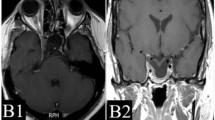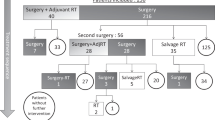Abstract
Purpose
The management of choice of non-functioning pituitary adenomas (NFPAs) remains debulking surgery when symptomatic. However, patient series systematically reporting the NFPAs outcome that were not treated either surgically, medically or with radiotherapy during long follow-up thereby giving an indication of their natural history are limited. Aim of the present study was to evaluate the natural course of presumed NFPAs, the outcome of confirmed NFPAs during a long follow-up period.
Methods
Between 1993 and 2013, 84 patients with presumed NFPA were studied retrospectively. Patients were enrolled based on the following criteria: imaging suggestive of pituitary adenoma, absence of any biochemical/clinical evidence of hormonal excess, exclusion of prolactinomas and at least one sequential imaging during the follow-up. Repeated assessment of the pituitary function, visual fields and imaging was performed at regular intervals. The follow-up duration was evaluated from the first and last imaging dates.
Results
In group F (follow-up without surgery, 33 patients), the macroadenomas showed a 15 % probability of tumor growth and reduction. Similar tumor size alterations were observed also for the microadenomas. In group S (surgery, 51 patients), both residual tumors (>1 and <1 cm) following initial surgical resection remain mainly stable until the last imaging.
Conclusions
Based on the given lack of approved medical treatment and the possible risks of surgical intervention in presence of significant comorbidities, our study proposes a conservative approach with a careful follow-up in patients with NFPAs without visual or neurological abnormalities.




Similar content being viewed by others
References
Tomlinson JW, Holden N, Hills RK, Wheatley K, Clayton RN, Bates AS, Sheppard MC, Stewart PM (2001) Association between premature mortality and hypopituitarism. Lancet 357:425–431
van der Klaauw AA, Kars M, Biermasz NR, Roelfsema F, Dekkers OM, Corssmit EP, van Aken MO, Havekes B, Pereira AM, Pijl H, Smit JW, Romijn JA (2008) Disease specific impairments in quality of life during long-term follow-up of patients with different pituitary adenomas. Clin Endocrinol 69:775–784
Greenman Y, Stern N (2009) Non-functioning pituitary adenomas. Best Pract Res Clin Endocrinol Metab 23:625–638
Davis JR, Farrell WE, Clayton RN (2001) Pituitary tumors. Reproduction 121:363–371
Buurman H, Saeger W (2006) Subclinical adenomas in postmortem pituitaries: classification and correlations to clinical data. Eur J Endocrinol 154:753–758
Saeger W, Lüdecke DK, Buchfelder M, Fahlbusch R, Quabbe HJ, Petersenn S (2007) Pathohistological classification of pituitary tumors: 10 years of experience with the German Pituitary Tumor Registry. Eur J Endocrinol 156:203–216
Yamada S, Ohyama K, Taguchi M, Takeshita A, Morita K, Takano K, Sano T (2007) A study of the correlation between morphological findings and biological activities in clinically nonfunctioning pituitary adenomas. Neurosurgery 61:580–585
Freda PU, Beckers AM, Katznelson L, Molitch ME, Montori VM, Post KD, Vance ML (2011) Pituitary incidentaloma: an endocrine society clinical practice guideline. J Clin Endocrinol Metab 96:894–904
Orija IB, Weil RJ, Hamrahian AH (2012) Pituitary incidentaloma. Best Pract Res Clin Endocrinol Metab 26:47–68
Kanner AA, Corn BW, Greenman Y (2009) Radiotherapy of nonfunctioning and gonadotroph adenomas. Pituitary 12:15–22
Minniti G, Jaffrain-Rea ML, Osti M, Cantore G, Enrici RM (2007) Radiotherapy for nonfunctioning pituitary adenomas: from conventional to modern stereotactic radiation techniques. Neurosurg Rev 30:167–175
Andersen M, Bjerre P, Schrøder HD, Edal A, Høilund-Carlsen PF, Pedersen PH, Hagen C (2007) In vivo secretory potential and the effect of combination therapy with octreotide and cabergoline in patients with clinically non-functioning pituitary adenomas. Clin Endocrinol 54:23–30
Behan LA, O’Sullivan EP, Glynn N, Woods C, Crowley RK, Tun TT, Smith D, Thompson CJ, Agha A (2013) Serum prolactin concentration at presentation of non-functioning pituitary macroadenomas. J Endocrinol Invest 36:508–514
Reincke M, Allolio B, Saeger W, Menzel J, Winkelmann W (1990) The ‘incidentaloma’ of the pituitary gland. Is neurosurgery required? JAMA 263:2772–2776
Ohta S, Yokoyama T, Uemura K (1998) Therapeutic strategy for incidentally found pituitary tumors (“pituitary incidentalomas”). Neurosurgery 43:1344–1350
Feldkamp J, Santen R, Harms E, Aulich A, Mödder U, Scherbaum WA (1999) Incidentally discovered pituitary lesions: high frequency of macroadenomas and hormone-secreting adenomas—results of a prospective study. Clin Endocrinol 51:109–113
Igarashi T, Saeki N, Yamaura A (1999) Long-term magnetic resonance imaging follow-up of asymptomatic sellar tumors. Their natural history and surgical indications. Neurol Med Chir 39:592–599
Sanno N, Oyama K, Tahara S, Teramoto A, Kato YA (2003) A survey of pituitary incidentaloma in Japan. Eur J Endocrinol 149:123–127
Karavitaki N, Collison K, Halliday J, Byrne JV, Price P, Cudlip S, Wass JA (2007) What is the natural history of nonoperated nonfunctioning pituitary adenomas? Clin Endocrinol 67:938–943
Dekkers OM, Hammer S, de Keizer RJ, Roelfsema F, Schutte PJ, Smit JW, Romijn JA, Pereira AM (2007) The natural course of non-functioning pituitary macroadenomas. Eur J Endocrinol 156:217–224
Donovan LE, Corenblum B (1995) The natural history of the pituitary incidentaloma. Arch Intern Med 155:181–183
Newton DR, Dillon WP, Norman D, Newton TH, Wilson CB (1989) Gd-DTPA-enhanced MR imaging of pituitary adenomas. Am J Neuroradiol 10:949–954
Nieman LK, Biller BM, Findling JW, Newell-Price J, Savage MO, Stewart PM, Montori VM (2008) The diagnosis of Cushing’s syndrome: an Endocrine Society Clinical Practice Guideline. J Clin Endocrinol Metab 93:1526–1540
Melmed S, Casanueva FF, Hoffman AR, Kleinberg DL, Montori VM, Schlechte JA, Wass JA (2011) Diagnosis and treatment of hyperprolactinemia: an Endocrine Society clinical practice guideline. J Clin Endocrinol Metab 96:273–288
Molitch ME, Clemmons DR, Malozowski S, Merriam GR, Vance ML (2011) Evaluation and treatment of adult growth hormone deficiency: an Endocrine Society clinical practice guideline. J Clin Endocrinol Metab 96:1587–1609
Arita K, Tominaga A, Sugiyama K, Eguchi K, Iida K, Sumida M, Migita K, Kurisu K (2006) Natural course of incidentally found nonfunctioning pituitary adenoma, with special reference to pituitary apoplexy during follow-up examination. J Neurosurg 104:884–891
Messerer M, Dubourg J, Raverot G, Bervini D, Berhouma M, George I, Chacko AG, Perrin G, Levivier M, Daniel RT, Trouillas J, Jouanneau E (2013) Non-functioning pituitary macro-incidentalomas benefit from early surgery before becoming symptomatic. Clin Neurol Neurosurg 115(12):2514–2520
Bradley KM, Adams CB, Potter CP, Wheeler DW, Anslow PJ, Burke CW (1994) An audit of selected patients with non-functioning pituitary adenoma treated by transsphenoidal surgery without irradiation. Clin Endocrinol 41:655–659
Lillehei KO, Kirschman DL, Kleinschmidt-DeMasters BK, Ridgway EC (1998) Reassessment of the role of radiation therapy in the treatment of endocrine-inactive pituitary macroadenomas. Neurosurgery 43:432–439
Scheithauer BW, Jaap AJ, Horvath E, Kovacs K, Lloyd RV, Meyer FB, Laws ER Jr, Young WF Jr (2000) Clinically silent corticotroph tumors of the pituitary gland. Neurosurgery 47:723–730
Greenman Y, Ouaknine G, Veshchev I, Reider-Groswasser II, Segev Y, Stern N (2003) Postoperative surveillance of clinically nonfunctioning pituitary macroadenomas: markers of tumour quiescence and regrowth. Clin Endocrinol 58:763–769
Turner HE, Stratton IM, Byrne JV, Adams CB, Wass JA (1999) Audit of selected patients with nonfunctioning pituitary adenomas treated without irradiation—a follow-up study. Clin Endocrinol 51:281–284
Tanaka Y, Hongo K, Tada T, Sakai K, Kakizawa Y, Kobayashi S (2003) Growth pattern and rate in residual nonfunctioning pituitary adenomas: correlations among tumor volume doubling time, patient age, and MIB-1 index. J Neurosurg 98:359–365
Acknowledgments
This research did not receive any specific grant from any funding agency in the public, commercial or not-for-profit sector.
Author information
Authors and Affiliations
Corresponding author
Ethics declarations
Conflict of interest
The authors declare that they have no conflict of interest.
Ethical approval
The authors declare that all the procedures performed in studies involving human participants were in accordance with the ethical standards of the institutional and/or national research committee and with the 1964 Helsinki declaration and its later amendments or comparable ethical standards.
Informed consent
The authors declare that an informed consent was obtained from all individual participants included in the study.
Rights and permissions
About this article
Cite this article
Karamouzis, I., Berardelli, R., Prencipe, N. et al. Retrospective observational analysis of non-irradiated non-functioning pituitary adenomas. J Endocrinol Invest 38, 1191–1197 (2015). https://doi.org/10.1007/s40618-015-0361-0
Received:
Accepted:
Published:
Issue Date:
DOI: https://doi.org/10.1007/s40618-015-0361-0




